ART/DOMESTIC 2021
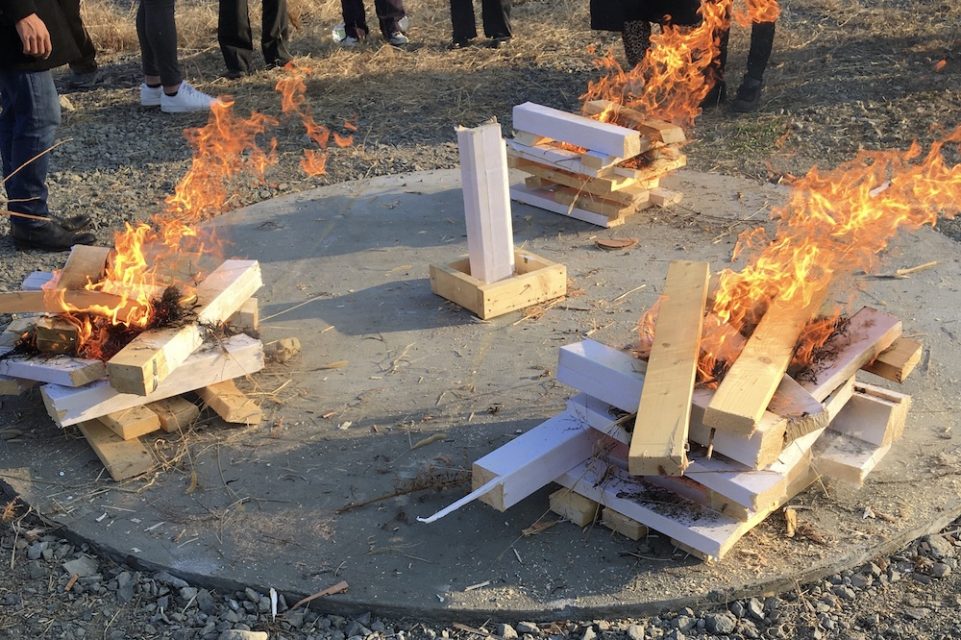 MOCAF (Museum of Contemporary Art Fukushima), March 11, 2021, Tomioka, Fukushima. Photo: Noi Sawaragi.
MOCAF (Museum of Contemporary Art Fukushima), March 11, 2021, Tomioka, Fukushima. Photo: Noi Sawaragi.
For me, it was as if the tenth anniversary of the 2011 Tohoku earthquake and tsunami on March 11 began the month before, with the magnitude 7.3 quake that struck off the coast of Fukushima prefecture at 11.07pm on February 13. As a result of this tremor, parts of Miyagi and Fukushima prefectures recorded shaking of 6-strong on the Japanese seismic scale. I happened to be in Kyoto to participate in an event related to the “Bubbles/Debris: Art of the Heisei Period 1989-2019” exhibition at the Kyoto City KYOCERA Museum of Art, for which I acted as curatorial supervisor. The shaking could be felt as far away as Kyoto. At first I thought I was experiencing mild dizziness, and only when I turned on a TV just afterwards did I learn about the earthquake. But the thing that surprised me most was that the Meteorological Agency announced that this quake was presumed to be an aftershock of the magnitude 9.0 Great East Japan earthquake that triggered the Tohoku disaster of nearly ten years earlier. In fact, at 1.44am the following day, a 20cm tsunami was observed at the port of Ishinomaki in Miyagi. According to one pundit, if the epicenter was shallower and the amount of energy released greater, a larger tsunami could have eventuated.
Then, some ten days after March 11 on the evening of March 20, a magnitude 6.9 quake struck Miyagi, and while a tsunami advisory was issued immediately afterwards, fortunately a tsunami was not observed. As with the earlier quake, it was announced that this, too, was an aftershock of the Great East Japan earthquake of ten years earlier.
I was reminded of how in the context of an earthquake of such a scale, a period of ten years is all but meaningless. Certainly, for an individual person, ten years is a significant amount of time, significant enough to look back on the past. However, when we compare it to earthquakes, which are a kind of physiological phenomenon of the earth, we are immediately pulled back into an ongoing maelstrom that may last for only an instant. Now that I think about it, for “Bubbles / Debris,” in contrast to the conventional wisdom of imagining art trends using a scale of a decade, I posed questions from the standpoint of Japanese imperial eras. After determining that the more-then-30-year-long Heisei era was a time of frequent disasters, I sought to build the entire exhibition around collective activities (bubbles/debris) by artists on the subject of what kind of art is possible during such a period.
Of course, in the context of time on a global scale, it is doubtful that 30 years is any more meaningful than ten years. Even so, I held out the faint hope that, compared to the Western system, in which time simply passes mechanically and systematically, a generation (which from ancient times has meant 30 years) based on the traditional Japanese calendar made up of the limited life spans of individual emperors would give a real sense, albeit only slightly, of time on a scale closer to people’s lives.
However, I am aware that because of this, “Bubbles/Debris” has been criticized as closing itself off inside the worldlessness of the Japanese imperial eras and lacking outwardness. The global standard known as “globalism,” which suddenly gathered pace with the collapse of the Berlin Wall in the very first year of the Heisei era and the spread around the world of an American-style ideology based on liberalism, democracy and capitalism, was promoted endlessly, as a result of which we saw climate change occur to the extent that it constitutes an obstacle to the continuance of the very existence of humankind. At the same time, the novel coronavirus, able to penetrate into places so small they are invisible to the naked eye, is spreading truly globally beyond capitalism, greatly limiting the activities of humankind due to its tremendous infectivity. Given these developments, we should perhaps reconsider the point of view that sees only superiority in global outwardness. Instead, I have come to feel that we actually need a perspective that enables us to get a real sense in a place closer to people’s lives that each individual human being is a finite life living with an actual “temperature,” and that amid this joy and sense of danger, it perceives our art not so much as the expression of independent individuals, but as collective work akin to facing a difficulty shoulder to shoulder.
This was not something I felt all that strongly about when I was planning the exhibition. When it came to the actual show, however, I created a chronology of the Heisei era from my own standpoint, and as I not so much read, but rather gazed at or physically experienced the 16-meter-long “Heisei Wall” that this chronology gave fruition to inside the venue while slowly walking past it, it gradually arose with a clear outline. And I think that this “physical experience” is probably most clearly expressed in the title of the exhibition “ART/DOMESTIC Temperature of the Time,” recorded under the year 1999 in this chronology (see Notes on Art and Current Events 29, or the 2013 related exhibition curated by this writer).
“ART/DOMESTIC Temperature of the Time” was the only exhibition planned by the late Takashi Azumaya, who went on to become one of then only a handful of people in Japan calling themselves independent curators, during his time as a curator at the Setagaya Art Museum. When I was informed by Azumaya himself of the contents of this exhibition, my interest was aroused above all by the title. And the first thing that struck me was that “ART/DOMESTIC” and “Temperature of the Time” were treated equally. At a time when the world was increasingly taking on a global aspect and circulating at an accelerated pace further and further away from people’s temperatures, Azumaya had taken it upon himself to put the word “temperature,” something spontaneous that only manifests within close contact / the absence of distance, in the title of his own exhibition. And he thought that this was the important significance of the fact that “ART” was “DOMESTIC” rather than “global.” In other words, “domestic” referred not to a sense of values running counter to the global age that everyone senses at a glance, but to conveying the temperature, so to speak, or making people think about art at an extremely close distance. Strangely enough, today, when the side effects of globalism are in the process of metamorphosing into unprecedented crises threatening humankind itself, such as climate change and the coronavirus pandemic, just as a yardstick for infection in the case of the latter is inferred from “temperature,” which is nowhere near a global distance, “temperature” has truly become a key word of the present “time.” Thus, due to the side effects and largest unpredictable “aftershocks” of the Heisei era, the world has truly entered a period in which everyone must continually measure the “temperature of the time.” In this sense, “Bubbles/Debris” may even be a variation in a different form in the Heisei era not on the exhibition “Ground Zero Japan” (Art Tower Mito) that I planned and supervised amid the transition from 1999 to 2000, but rather on “ART/DOMESTIC Temperature of the Time” organized by Azumaya at the beginning of that same year.
Incidentally, at a time when websites were not as common as they are today, Azumaya wrote as follows concerning the aims of this exhibition, which barely remains as a vestige of that era:
This is an exhibition of contemporary DOMESTIC ART.
The participants in this special exhibition are not gazing at their own environment or everyday lives from the outside, but continually creating things from their very midst. Yoshitomo Nara expresses in paintings and sculptures the simple emotions felt similarly by people of the same age; Masami Tada uses familiar materials to turn internal impulses into actions; Yuichi Higashionna reveals the feelings of discomfort latent in everyday life using objects commonly found around the home; Atsuko Tanaka continues to respond calmly and steadily to her impulses by depicting the same motifs while paying no heed to concepts or the fashions of the day; manga artist Takashi Nemoto delineates the private parts of our society and our minds; video artist Hiroyuki Ohki addressed himself to the people/scenery around him with love and desire; and Shinro Ohtake assimilates and visualizes/auralizes the disorderly culture surrounding us, including pop music and karaoke. What these artists have in common is that they value their own impulses and the feel of things more than theory, and that they never become worked up. The heat that accompanies their expression is something I sense as the temperature of this time. ART of Japan as a somewhere DOMESTIC. This is “our” exhibition as people living through this period.
(From the Setagaya Art Museum website)
Here, “domestic” is being proposed as an antonym of “global,” and its value as something that is actually “close,” as a kind of “heat” that is lost the farther away it is. Its nuance is completely different from the word “national,” the use of which suddenly became rampant in the second half of the Heisei period. In this sense, “national” is actually well matched with “global.” As the world became more globalized, people whose living skills were diminished along with the “temperature of the time” and who lost any “closeness” worthy of belief became estranged from their families and isolated, and came to depend with the aid of the internet on an abstract nationalism. However, from the standpoint of capitalism, it is actually groups of people that have become symbolized, broken up and isolated and had their connections cut off in this way that are the most manageable material in terms of making a profit. Which is why “national” and “domestic,” which must never be confused, should not be thought of as the same simply by using the term “Japanese.” Rather, being “domestic” is actually one of the few means of resisting becoming global (ie, national).
But to return to my earlier point, this resurfacing of the concept of “ART/DOMESTIC Temperature of the Time,” a surprise even to me, coincided with the build-up to the tenth anniversary of the Tohoku earthquake and tsunami. The “aftershock” of the Great East Japan earthquake that occurred suddenly off the coast of Fukushima on the night of February 13 was a powerful reminder that even after ten years, the “temperature” of the Japanese archipelago on which we live has yet to drop, that in fact another disaster could easily strike any time, anywhere, and that we are “close” to such a place. Constructing art of our time from within our own unique domestic sense of temperature, without being swallowed up by global abstractness, in the current circumstances in which our movement overseas is drastically curtailed by the coronavirus pandemic and we must wear masks wherever we go. I felt that this more than anything was the kind of art we really needed to think about now.
In this sense, my experience judging an art exhibition in Iwaki, to where I headed on the Joban line on February 16, just days after the February 13 aftershock when its aftereffects still lingered, gave me an actual tactile impression of this kind of domestic art. I had been asked to judge the Painting/Sculpture section of the “Iwaki Citizens’ Art Exhibition,” held this year for the 50th time, and spent the following day, February 17, at the Iwaki City Art Museum where the exhibition was being held. There was no visible damage from the quake in the city center, and while some faults were detected in gas pipes at the museum after I left, requiring the museum to temporarily close for a very brief period, the judging and the exhibition itself went ahead without a hitch. However, despite it being a major milestone in the form of the exhibition’s 50th anniversary, I was unable to attend any festive award or other ceremonies, and events on the day of the judging were also conducted with social distancing to prevent the spread of the coronavirus, with none of the customary closing parties. Even so, I felt that I had certainly encountered at this exhibition something that could be called the “temperature of the time,” and was aware of myself sensing with my own skin an interest in domestic art the likes of which I had never experienced before.
 50th Iwaki Citizens’ Art Exhibition, Painting/Sculpture section, Mayor of Iwaki Award: Shouken – Natsui River, Taira Bridge and Taira Second Elementary and Middle Schools (2021), oil on board, 45.6 x 55 cm.
50th Iwaki Citizens’ Art Exhibition, Painting/Sculpture section, Mayor of Iwaki Award: Shouken – Natsui River, Taira Bridge and Taira Second Elementary and Middle Schools (2021), oil on board, 45.6 x 55 cm.


Left: 50th Iwaki Citizens’ Art Exhibition, Painting/Sculpture section, Iwaki City Assembly Chairman’s Award: Yoshiharu Watanabe – Recollection (Jomon) (2021), oil on canvas, 162.1 x 130.3 cm.
Right: Superintendent of Education Award: Hiroko Kuge – 2020 Late Autumn – Morning Glory (2020), oil on canvas, 91 x 72.8 cm.
At the end of the month, from February 26 to 27, I visited Fukushima for the second time this year. This was part of the regular research I am doing in conjunction with “Don’t Follow the Wind,” an international contemporary art project in the “difficult-to-return zone” that also led to me becoming involved as a participating artist in the exhibition “Artists and the Disaster: Imagining in the 10th Year” held at Art Tower Mito. The main purpose of this visit was to make additions to and carry out maintenance work on the exhibits in a venue in a part of the difficult-to-return zone, where Grand Guignol Mirai, of which I am a member and who was presenting an exhibit of reedited footage at the Art Tower Mito exhibition, has installed a work.
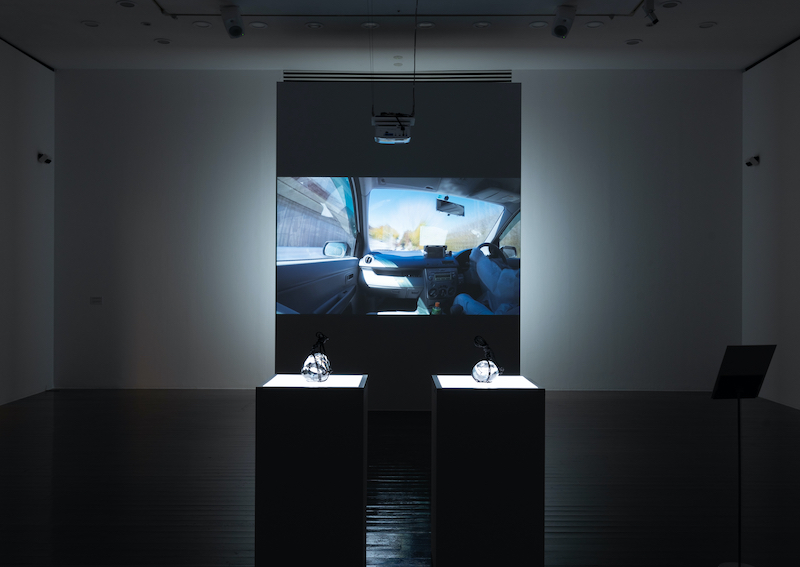 Installation view of “Artists and the Disaster: Imagining in the 10th Year” (2021) at the Contemporary Art Gallery, Art Tower Mito. Foreground: Aiko Miyanaga – Tome-ishi (2015/2020). Background: Grand Guignol Mirai – Grand Guignol Mirai 2020 (2020). Photo Yuzuru Nemoto, courtesy Don’t Follow the Wind and Mizuma Art Gallery.
Installation view of “Artists and the Disaster: Imagining in the 10th Year” (2021) at the Contemporary Art Gallery, Art Tower Mito. Foreground: Aiko Miyanaga – Tome-ishi (2015/2020). Background: Grand Guignol Mirai – Grand Guignol Mirai 2020 (2020). Photo Yuzuru Nemoto, courtesy Don’t Follow the Wind and Mizuma Art Gallery.
The addition I made personally to the exhibit at that time was of water related to the Engine in the Water Restart Storage Water Distribution initiative, for which the Osamu Kokufu Engine in the Water Re-creation Project, also part of “Bubbles / Debris,” was re-launched. Because the events surrounding the evolution of this project are so extremely complex, they would be difficult to summarize here. Those interested in the details are advised to check out these documents concerning the project, as well as my earlier column (Notes on Art and Current Events 69) written about this project. In short, the project has its origins in the sudden accidental death of Osamu Kokofu while inspecting an exhibit at an exhibition in 2014, and involves a group of interested people trying to “re-create” (including discussing the rights and wrongs) the uncommonly difficult-to-realize artwork (?) that is Engine in the Water through repeated trial and error, given that the artist himself did not leave behind any written instructions. During “Bubbles/Debris,” these people decided to distribute as “storage water” (1500 x 500ml plastic bottles of water to run Engine in the Water = 750l) the water required to restart Engine No. 3, which is currently buried in the ground, ten years from now in 2031 (for details, see the “Osamu Kokufu Engine in the Water Redux” website).
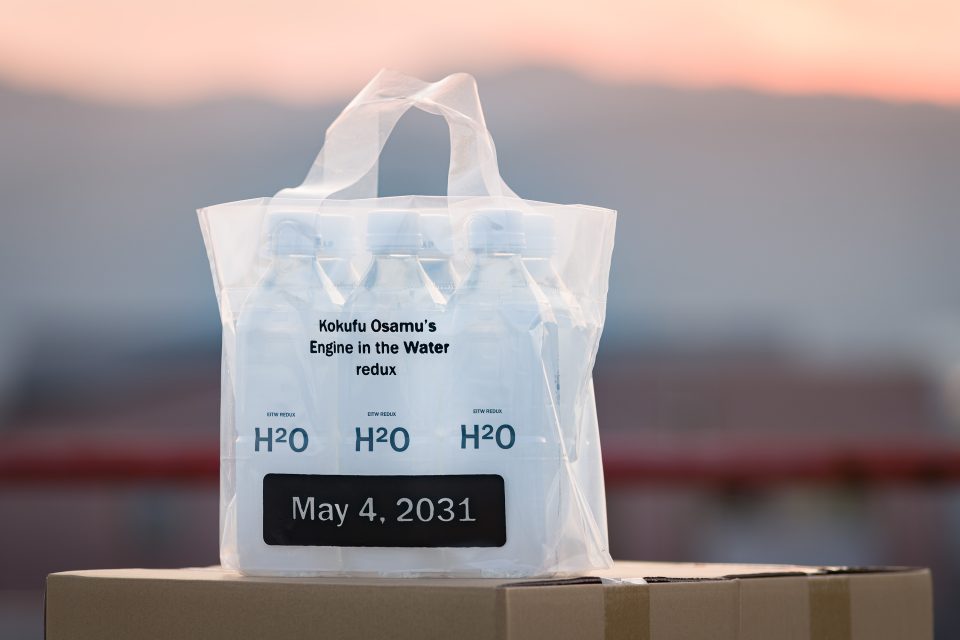 Storage water distributed in conjunction with “Osamu Kokufu Engine in the Water Redux.” Photo Tomas Svab, courtesy Osamu Kokufu Engine in the Water Re-creation Project. For details (in Japanese) about the storage water distribution see here. The package design (by Toshiyuki Nakaie) relates to Kokufu’s ”CO2 Cube” (2004) project.
Storage water distributed in conjunction with “Osamu Kokufu Engine in the Water Redux.” Photo Tomas Svab, courtesy Osamu Kokufu Engine in the Water Re-creation Project. For details (in Japanese) about the storage water distribution see here. The package design (by Toshiyuki Nakaie) relates to Kokufu’s ”CO2 Cube” (2004) project.
As mentioned on the above site, this water was distributed at a specially set-up museum shop at the Kyoto City KYOCERA Museum of Art from March 14, ten years after the 2011 Tohoku earthquake and tsunami, and is due to be recovered at Okazaki Park in front of Heian Jingu shrine, also in Kyoto, on May 4, 2031, when the “restart” will commence. The shelf life of the storage water is five years, so if by any chance the bearers happen to get caught up in a disaster within that period and need water, they can drink it or use it for some other purpose. In that event, however, there is a note explaining that the empty bottles should be refilled with tap water in preparation for their recovery in 2031.
I actually wanted to add some of the storage water for this project to the Grand Guignol Mirai exhibit site inside the difficult-to-return zone, but because I went to Fukushima before March 11, I bought some bottled water at a convenience store operating outside the zone and installed that instead. While this was not the same as the officially distributed storage water, with the prior agreement of the members of the project, this water remains stored inconspicuously with no one around inside the difficult-to-return zone. During my entry into the zone on February 26, I felt an aftershock while working at the site, and I imagine the surrounding area experienced some major shaking as a result of the February 13 tremor. In fact I was able to actually observe some effects of that quake. If anyone is caught up in a major disaster while inside the zone, then the water I delivered might be of some use. In any case, this storage water for the future restart of Engine in the Water now has two possible futures, though which will come first is uncertain, for in addition to it being open to public viewing when the blockade on the difficult-to-return zone is lifted, it may also be used when Engine in the Water is restarted in 2031.
So, after all these twists and turns, where was I at the critical moment of 2:46 pm on March 11? In fact, I was at the site of the former home of a man in the town of Tomioka in Fukushima prefecture, not far from the difficult-to-return zone. It was this man who gave Grand Guignol Mirai the opportunity to establish a venue inside the zone. He also came up with the idea of opening at 2:46 pm on March 11, exactly ten years after the earthquake hit, a conceptual art museum on the vacant site where his house, which was demolished in the wake of the disaster, once stood. The museum is called MOCAF (Museum of Contemporary Art Fukushima), the director is art director Yutaro Midorikawa (who is also in charge of planning) and the deputy director local activist Riken Komatsu, meaning that it is run by people from Fukushima, while the land owner, Kazuhiro Onuki, whom I referred to above as “this man,” is MOCAF’s chairman. Also involved as special advisor is Mine Oka, an artist from Iwaki who plays a leading role in the management of the Iwaki City Art Museum. I should also mention that it was through the introduction of Oka that we came to know Onuki. In this sense, one could probably say that the Iwaki City Art Museum and MOCAF share the same heat and “temperature of the time” for personal/local actions and practices related to the Fukushima disaster.
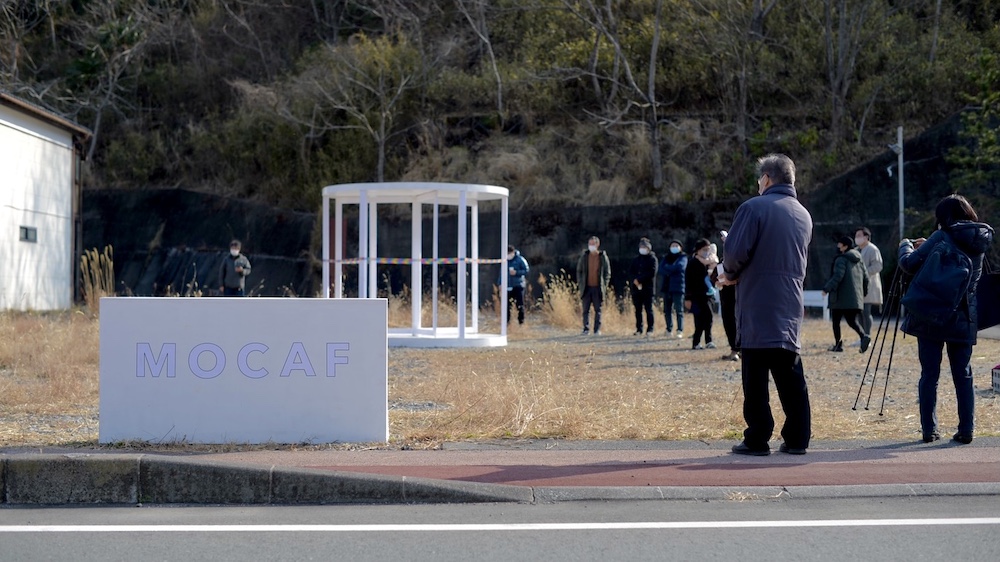
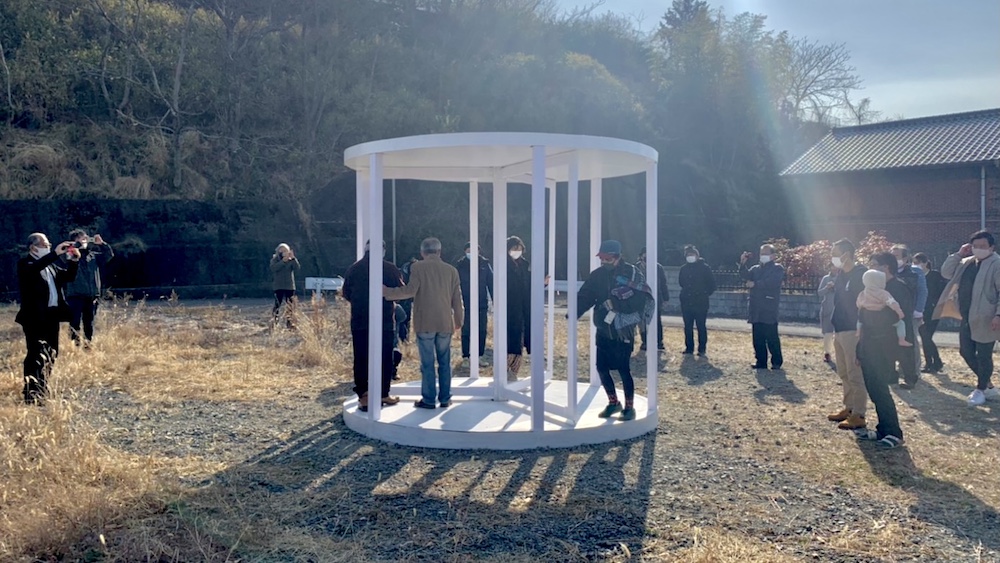
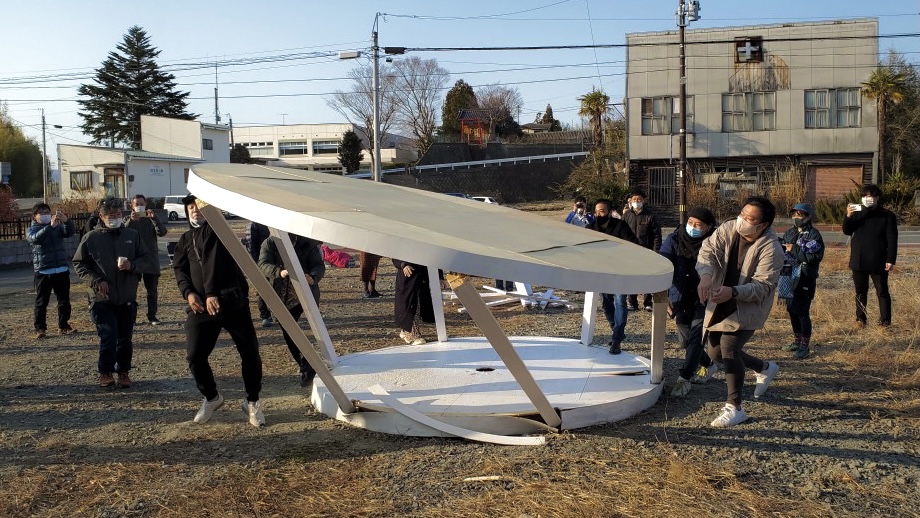 MOCAF (Museum of Contemporary Art Fukushima), March 11, 2021, Tomioka, Fukushima. Photos courtesy MOCAF.
MOCAF (Museum of Contemporary Art Fukushima), March 11, 2021, Tomioka, Fukushima. Photos courtesy MOCAF.
In fact, MOCAF consisted of a self-built, white revolving door. Soon after opening at 2:46 pm with a silent prayer followed by a ribbon-cutting ceremony, it was “closed” at 4:00 pm the same day and dismantled, with parts of it burned onsite. The beginning was also the end, in which sense this peculiar art museum opening ceremony that repeated like a revolving door a cycle in which the end is also the beginning, was at the same time a cremation. Also in attendance were Ryuta Ushiro of “Don’t Follow the Wind” initiators Chim↑Pom, DFTW participating artist Kota Takeuchi and exhibition curator Kenji Kubota; as well as Bontaro Dokuyama, Tsubasa Kato and Makoto Aida.
But what prompted MOCAF to realize such a peculiar idea to begin with? In a written statement he issued dated March 11, 2021, titled “Why MOCAF? ” Midorikawa explains the thinking behind the idea and how it was born. At the same time was superimposed Onuki’s having come to cherish one of Japan’s greatest classics of disaster literature, Kamo no Chomei’s Hojoki (The Ten Foot Square Hut) in the wake of the Fukushima disaster. In that sense, MOCAF may just be a future form of Hojo-an, or tiny hut as a place to flee to escape disasters and ponder/meditate on one’s own. If so, it would mean MOCAF had a connection to “Bubbles/Debris,” which was initially inspired by the famous reference to utakata (“foam” or “bubbles”) in the opening lines of the Hojoki.
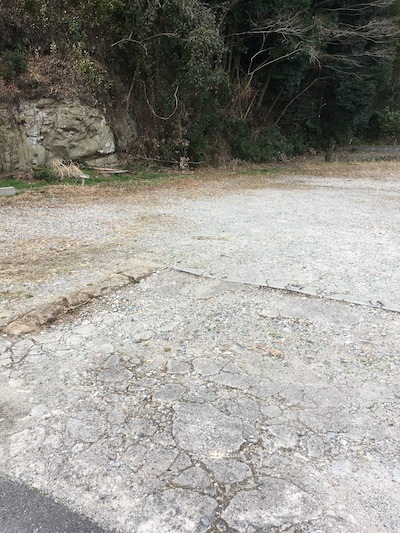 Former site of the Mihako Theater, March 12, 2021, Iwaki, Fukushima. Photo Noi Sawaragi.
Former site of the Mihako Theater, March 12, 2021, Iwaki, Fukushima. Photo Noi Sawaragi.
Speaking of tiny huts, on March 12 I visited Yumoto, which is also in Iwaki. Looking back, my connection with Fukushima arose from my involvement with the Mihako Theater, a house of entertainment typical of entertainment districts in old coal-mining towns that was still standing around the time of the 2011 Tohoku earthquake and tsunami, or in other words a dream tiny hut (see Notes on Art and Current Events 39). On that day, I went to the former site of the Mihako Theater, the very starting point of my relationship with the Great East Japan earthquake about which I have written so much and a place where I can sense an actual temperature. The Mihako Theater itself was demolished long ago, and the site on which it stood is still vacant, with just some of the foundations visible. However, despite the building having been removed, the place is still for me a starting point. As seen in the Osamu Kokufu Engine in the Water Re-creation Project, the activities of Grand Guignol Mirai inside the difficult-to-return zone, and MOCAF, where loss and birth occur simultaneously, we are constantly trying to restore connections with things we have lost while breathing, huddling close together and feeling each other’s body temperature in the places we inhabit. Dead people are perhaps the perfect example of this. The dead are always close to us in our memories, yet infinitely far away. It is a long time since we lost their temperatures. Yet they continue to remain for a long time as the “temperature of the time.” Is it possible to discover that heat once again as “ART/DOMESTIC”? That is what I strongly desire right now.
“Bubbles / Debris: Art of the Heisei Period 1989–2019”, for which Noi Sawaragi oversaw planning and implementation, was held from January 23 through April 11, 2021, at the Kyoto City KYOCERA Museum of Art.
